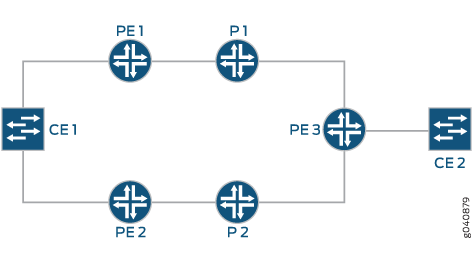VPLS Multihoming Overview
Virtual private LAN service (VPLS) multihoming enables you to connect a customer site to two or more PE routers to provide redundant connectivity. A redundant PE router can provide network service to the customer site as soon as a failure is detected. VPLS multihoming helps to maintain VPLS service and traffic forwarding to and from the multihomed site in the event of the following types of network failures:
PE router to CE device link failure
PE router failure
MPLS-reachability failure between the local PE router and a remote PE router

In the VPLS documentation, the word router in terms such as PE router is used to refer to any device that provides routing functions.
Figure 1 illustrates how a CE device could be multihomed to two PE routers. Device CE1 is multihomed to Routers PE1 and PE2. Device CE2 has two potential paths to reach Device CE1, but only one path is active at any one time. If Router PE1 were the designated VPLS edge (VE) device (also called a designated forwarder), BGP would signal a pseudowire from Router PE3 to Router PE1. If a failure occurred over this path, Router PE2 would be made the designated VE device, and BGP would re-signal the pseudowire from Router PE3 to Router PE2.
Multihomed PE routers advertise network layer reachability information (NLRI) for the multihomed site to the other PE routers in the VPLS network. The NLRI includes the site ID for the multihomed PE routers. For all of the PE routers multihomed to the same CE device, you need to configure the same site ID. The remote VPLS PE routers use the site ID to determine where to forward traffic addressed to the customer site. To avoid route collisions, the site ID shared by the multihomed PE routers must be different than the site IDs configured on the remote PE routers in the VPLS network.
Although you configure the same site ID for each of the PE routers multihomed to the same CE device, you can configure unique values for other parameters, such as the route distinguisher. These values help to determine which multihomed PE router is selected as the designated VE device to be used to reach the customer site.
We recommend that you configure unique route distinguishers for each multihomed PE router. Configuring unique route distinguishers helps with faster convergence when the connection to a primary multihomed PE router goes down. If you configure unique route distinguishers, the other PE routers in the VPLS network must maintain additional state for the multihomed PE routers.
Remote PE routers in the VPLS network need to determine which of the multihomed PE routers should forward traffic to reach the CE device. To make this determination, remote PE routers use the VPLS path-selection process to select one of the multihomed PE routers based on its NLRI advertisement. Because remote PE routers pick only one of the NLRI advertisements, it establishes a pseudowire to only one of the multihomed PE routers, the PE router that originated the winning advertisement. This prevents multiple paths from being created between sites in the network, preventing the formation of Layer 2 loops. If the selected PE router fails, all PE routers in the network automatically switch to the backup PE router and establish new pseudowires to it.
To prevent the formation of Layer 2 loops between the CE devices and the multihomed PE routers, we recommend that you employ the Spanning Tree Protocol (STP) on your CE devices. Layer 2 loops can form due to incorrect configuration. Temporary Layer 2 loops can also form during convergence after a change in the network topology.
The PE routers run the BGP path selection procedure on locally originated and received Layer 2 route advertisements to establish that the routes are suitable for advertisement to other peers, such as BGP route reflectors. If a PE router in a VPLS network is also a route reflector, the path selection process for the multihomed site has no effect on the path selection process performed by this PE router for the purpose of reflecting Layer 2 routes. Layer 2 prefixes that have different route distinguishers are considered to have different NLRIs for route reflection. The VPLS path selection process enables the route reflector to reflect all routes that have different route distinguishers to the route reflector clients, even though only one of these routes is used to create the VPLS pseudowire to the multihomed site.
Junos OS supports VPLS multihoming for both BGP VPLS and FEC129 VPLS. See Feature Explorer for information on platform and release support for any VPLS-related feature.
